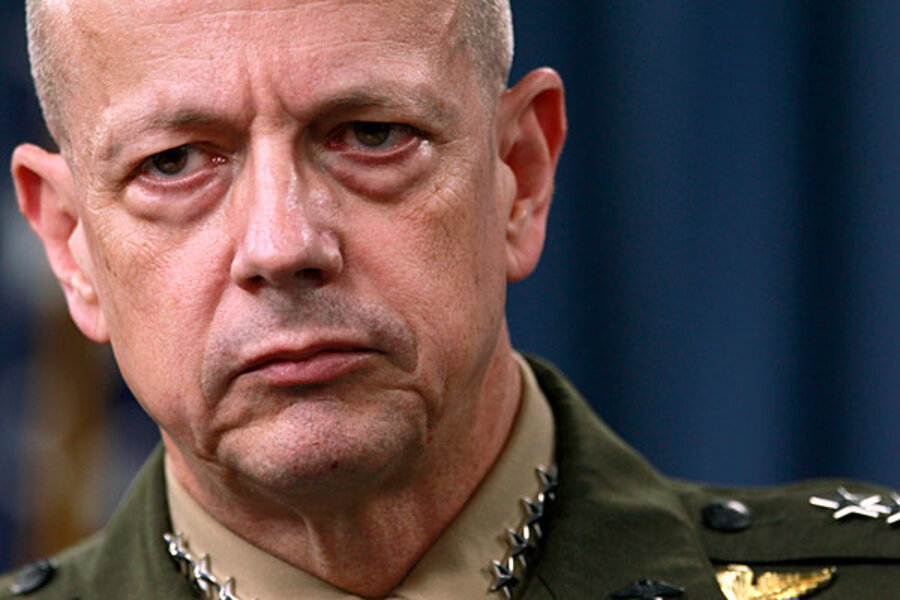Latest photo scandal: US soldiers pose with dead Afghan insurgents
Loading...
| Kabul
Already tense U.S. and NATO ties with Afghanistan were dealt another blow on Wednesday with photographs appearing in an American newspaper of U.S. soldiers posing with the maimed bodies of dead Afghan insurgents.
Senior US officials and NATO's top commander in the country, US Gen. John Allen, moved quickly to condemn the pictures even before they were published by the Los Angeles Times, which received the photos from another soldier.
"The actions of the individuals photographed do not represent the policies of International Security Assistance Force or the U.S. Army," General Allen said in a statement, adding an investigation into the incident was underway.
RELATED: Afghanistan: Five areas of concern after US exits
An American soldier said that he gave the photos to the Los Angeles Times to draw attention to the breakdown in leadership and discipline among US troops in Afghanistan.
The appearance on the LA Times website of some of the 18 pictures, taken in 2010, comes at a sensitive time in U.S.-Afghan relations, following release of a video in January that showed four US Marines urinating on Afghan insurgent corpses.
In February, 10 US Marine Corps snipers in Afghanistan posed for a photography with a Nazi SS flag.
The inadvertent burning of copies of the Koran at a major NATO airbase also triggered a week of riots that left 30 dead and led to the deaths of six Americans.
And in March a U.S. Army sergeant went on a nighttime shooting rampage in two southern Afghan villages, killing 17 civilians and prompting Afghan President Hamid Karzai to demand foreign soldiers confine themselves to major bases.
Taliban insurgents launched suicide attacks in Kabul and three other provinces at the weekend, claiming the assault was launched in retaliation for all three incidents.
In one of the pictures a paratrooper posed next to an unofficial patch placed beside a body that read "Zombie Hunter", while in another soldiers posed with Afghan police holding the severed legs of an insurgent bombers.
Two soldiers in another frame held a dead insurgent's hand with the middle finger raised.
The LA Times said the 82nd Airborne Division soldiers had been at a police station in Afghanistan's Zabol province in February 2010, and revisited several months later. The pictures were taken on both occasions.
US Defense Secretary Leon Panetta said in a statement released by departmental spokesman George Little that publication of the pictures could prompt further attacks against security forces ahead.
"The danger is that this material could be used by the enemy to incite violence against U.S. and Afghan service members in Afghanistan," Panetta said. "U.S. forces in the country are taking security measures to guard against it."
The US Ambassador in Afghanistan Ryan Crocker also condemned the photographs, calling the actions of the soldiers "morally repugnant" and saying they "dishonor the sacrifices of hundreds of thousands of U.S. soldiers and civilians who have served with distinction in Afghanistan".
The Times defended the distribution of the photos, which U.S. military officials asked the Times not to publish.
"After careful consideration, we decided that publishing a small but representative selection of the photos would fulfil our obligation to readers to report vigorously and impartially on all aspects of the American mission in Afghanistan," Times Editor Davan Maharaj said in the newspaper's article.
The photos are likely to stir up more anti-Western sentiment in Afghanistan as NATO combat troops look to exit the country in 2014 and strengthen fragile security in the country.
Such incidents have complicated U.S. efforts to negotiate a strategic partnership agreement to define its presence once most foreign combat troops pull out by the end of 2014.
In 2004, photos of US soldiers doing things to humiliate Iraqi detainees ultimately led to the exposure of abuse and torture at the Abu Ghraib prison.
(Editing by Rob Taylor and Ed Lane)





